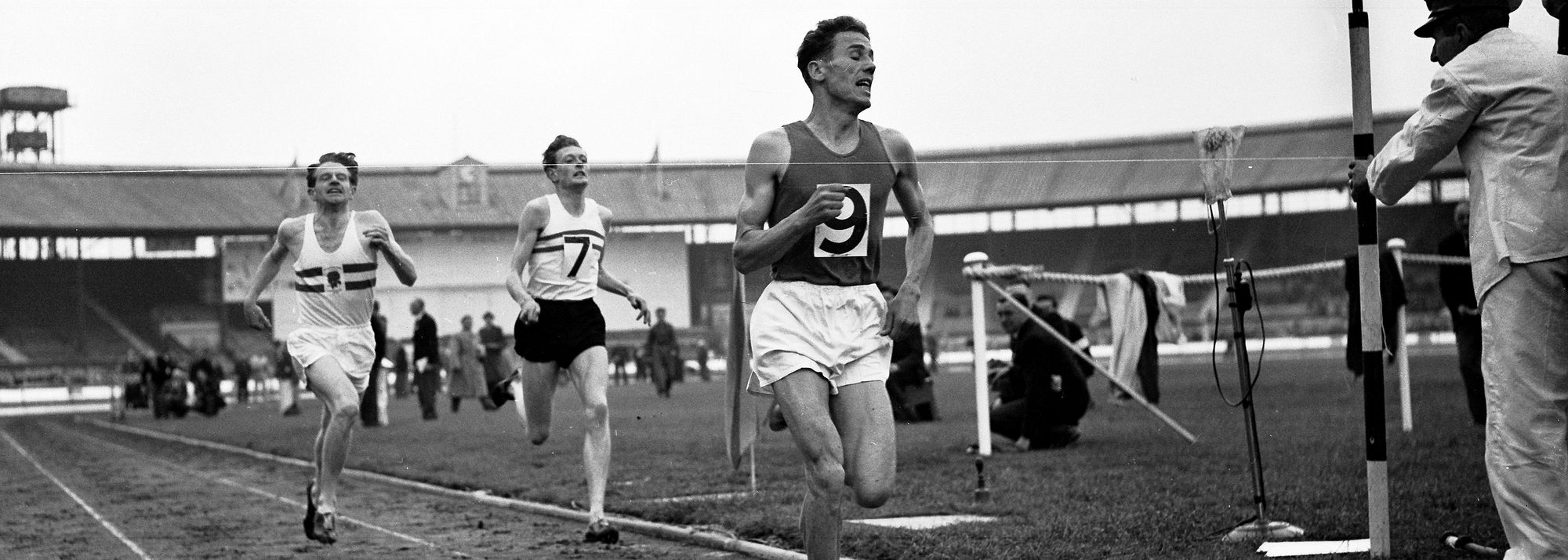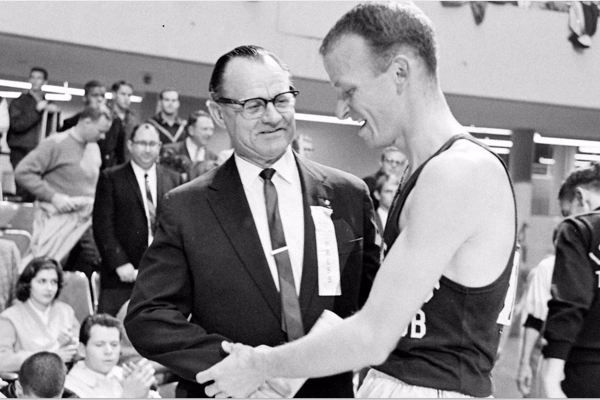Laszlo Tabori becoming the third man to go sub-four-minutes for the mile on 28 May 1954 (© Associated Press)
The MOWA Heritage Athletics Exhibition in Etele Plaza, Budapest’s newest shopping mall (3rd Floor, Etele Plaza, Budapest, Hadak utja 1, 1119 Hungary), features items showcasing many of the greats of Hungarian track and field.
The exhibition will be open to the public for five months, closing on the final day of the World Athletics Championships Budapest 23 (19-27 August 2023).
Opened by World Athletics CEO Jon Ridgeon and Balazs Nemeth, CEO of the World Athletics Championships Budapest 23, the exhibition includes the treasured number worn by Laszlo Tabori when he became only the third runner in history to run a mile inside four minutes.
Following in the spike-marks of Britain’s Roger Bannister and Australian John Landy, Tabori clocked 3:59.00 in outsprinting European 5000m champion Chris Chataway to win the invitation mile in the British Games at London’s White City Stadium on 28 May 1955.
He also equalled the world 1500m record held by his training partner Sandor Iharos, running 3:40.8 in Oslo in September 1955, and featured in three world record-breaking 4x1500m relay teams guided by the legendary Hungarian coach Mihaly Igloi.
Tabori claimed he learned to run fast during World War Two, by stealing food and fleeing from German soldiers. His preparations for the 1956 Olympics impacted by the Soviet invasion of Hungary, he finished fourth in the 1500m and sixth in the 5000m in Melbourne.
Tabori subsequently followed Igloi to the United States, where he acted as a pacemaker in Jim Beatty’s successful attempt on the first sub-four-minute mile indoors in 1962. He then turned to coaching and helped the pioneering Jaqi Hansen become the first woman to break 2:40 for the marathon in 1975.
Tabori was honoured in 2002 with the International Olympic Committee’s Fair Play Award, for lifetime achievement and outstanding contribution to track and field. He died in 2018, aged 86.
Hand-made hammer
Another of the gems on display in the MOWA Heritage Athletics Exhibition is the first hammer ever used by Gyula Zsivotsky, made by the 1968 Olympic champion himself. Also on show is the Hungarian team sweatshirt worn by the late, great Budapest native at those Games in Mexico City.
The Olympic silver medallist in Rome in 1960 and in Tokyo in 1964, Zsivotsky was expected to collect another consolation prize in Mexico, even though he was the world record-holder at the time, having eclipsed Hal Connolly’s old mark by a 2.48m with a massive 73.74m in Debrecen in 1965 and improved it by 2cm in Budapest a month before the Games.
Defending champion Romuald Klim started favourite. Unbeaten in three years, the Belarus-Soviet had defeated Zsivotsky in nine successive competitions. In the final, however, the Hungarian took the gold by 8cm with an Olympic record 73.36m.
Zsivotsky died in Budapest in 2007, aged 70. His son, Attila, won the world U20 decathlon title in 1996 and claimed bronze at the 2005 World Athletics Championships in Helsinki, behind two giants of multi-events, Bryan Clay of the USA and Roman Sebrle of the Czech Republic.
Pars’ Olympic shoes and bib number
The shoes and number worn by Krisztian Pars when he became Olympic hammer champion in London in 2012 are also on display.

Krisztian Pars competes at the London 2012 Olympic Games (© Getty Images)
A prolific teenage talent, who won the world U18 title in 1999, Pars finished fourth in the Olympic finals of 2004 and 2008 and stepped up to senior global podium status with a silver behind Japan’s Koji Murofushi at the 2011 World Athletics Championships in Daegu. Pars took another silver in Moscow in 2013.
He won Olympic gold in London with a third-round effort of 80.59m, the only 80m-plus throw of the competition, and also claimed European titles in 2012 and 2014.
Pars was coached in his younger days by Pal Nemeth and in his later years by Nemeth’s son, Zsolt. Winner of the World Student Games title and runner up to Germany’s Karsten Kobs at the World Athletics Championships in Seville in 1999, Zsolt Nemeth has donated a trophy from his own international hammer career to the vast MOWA Heritage Athletics Exhibition.
Hungary’s rich hammer tradition naturally features heavily in the impressive collection. Another exceptional item on show is the hammer thrown by Tibor Gecsek when he won the European title at the Nepstadion in 1998. Fuelled by the roars of the Budapest crowd, the two-time world bronze medallist threw a mighty 82.87m to claim a hugely popular home gold.
Golden shoe
Long jumper Laszlo Szalma also got to savour European success on home ground. The second of his European indoor titles was achieved in Budapest, with a leap of 7.93m in 1983. Szalma, who set the still-enduring Hungarian outdoor record of 8.30m in Budapest in 1985, has donated the golden shoe he won as Hungary’s Athlete of the Year.
Also on display are the European indoor gold medals won by triple jumper Bela Bakosi in Sindelfingen in 1980 and in Milan in 1982. In all, Bakosi hopped, stepped and jumped to seven European indoor medals, including a bronze and silver in Budapest in 1983 and 1988.
Anita Marton has kindly loaned the Rio 2016 Olympic bronze and world silver medals from London the following year. The 2018 world indoor champion has also provided the competition mascots with which she was presented in Rio and London.

Anita Marton with her world silver medal in London in 2017 (© AFP / Getty Images)
Another Hungarian who made the podium at the 2017 World Athletics Championships, Balazs Baji has generously donated the whole kit and kaboodle from his productive London experience: the bronze medal he won behind Omar McLeod and Sergey Shubenkov in the 110m hurdles final, plus his shoes, singlet and number.
“Not possible to beat Bubka”
Also on display is a silver medal from the 1991 World Athletics Championships in Tokyo. It might have been a sensational gold but the Budapest-born Istvan Bagyula found himself trumped at the death in a dramatic pole vault duel with Sergey Bubka.
Seeking a hat-trick of world outdoor titles, Bubka had been struck by injury and had three pain-killing injections before the competition. Had the Ukrainian master of the event missed a last gasp shot at 5.95m, the gold would have gone to Bagyula, but the struggling Bubka managed to scrape over the bar.
Bagyula was left with the silver medal as consolation for his own success at 5.90m. “It’s just not possible to beat Bubka,” he lamented.
Simon Turnbull for World Athletics







